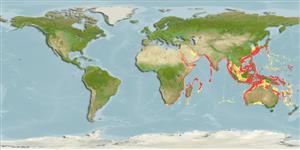Environment: milieu / climate zone / depth range / distribution range
Ecologie
marien benthopelagisch; diepte 2 - 1190 m (Ref. 40919). Tropical
Indo-West Pacific: Red Sea and False Bay, South Africa to Vanuatu, north to southern Japan, south to Australia.
Grootte / Gewicht / Leeftijd
Maturity: Lm ? range ? - ? cm
Max length : 53.0 cm SL mannelijk / geslacht onbekend; (Ref. 4404)
Korte beschrijving
Determinatiesleutels | Morfologie | Morfometrie
Dorsale stekels (totaal) : 13 - 14; Dorsale zachte stralen (totaal) : 105 - 119; Anale stekels: 2; Anale zachte stralen: 107 - 119. Easily distinguished from other blennies by an extremely elongate body. Dorsal fin origin above eye.
Adults occur on open soft-bottom and mud habitats from shallow bays to deep water. They are found in tube-like burrows in sand or mud bottoms (Ref. 9710). Very rarely encountered but more usually seen at night (Ref. 90102). Nocturnal feeders. Stomach of two specimens trawled in 50-54 m off western India contain crustaceans (including copepods), polychaete remains, forams, fish scales, and some sand and mud (Ref. 11441). Oviparous. Eggs are demersal and adhesive (Ref. 205), and are attached to the substrate via a filamentous, adhesive pad or pedestal (Ref. 94114). Larvae are planktonic, often found in shallow, coastal waters (Ref. 94114). Have eel-like bodies but are rarely seen swimming away from their burrow (Ref. 48636).
Levenscyclus en paargedrag
Maturities | Voortplanting | Spawnings | Egg(s) | Fecundities | Larven
Oviparous, distinct pairing (Ref. 205).
Randall, J.E., G.R. Allen and R.C. Steene, 1990. Fishes of the Great Barrier Reef and Coral Sea. University of Hawaii Press, Honolulu, Hawaii. 506 p. (Ref. 2334)
Status op de Rode Lijst van het IUCN (Ref. 130435)
Gevaar voor de mens
Harmless
Gebruik door de mens
Visserij: commercieel; Aquarium: Commercieel
Tools
Speciale rapporten
Download XML
Internetbronnen
Estimates based on models
Preferred temperature (Ref.
123201): 8 - 19.8, mean 12.4 °C (based on 836 cells).
Fylogenetische diversiteitsindex (Ref.
82804): PD
50 = 0.7500 [Uniqueness, from 0.5 = low to 2.0 = high].
Bayesian length-weight: a=0.00102 (0.00046 - 0.00225), b=3.06 (2.88 - 3.24), in cm total length, based on all LWR estimates for this body shape (Ref.
93245).
Trofisch niveau (Ref.
69278): 3.9 ±0.5 se; based on size and trophs of closest relatives
Weerstandsvermogen (Ref.
120179): Gemiddeld, minimale populatieverdubbelingstijd 1,4-4,4 jaar (Assuming tm=1-3 and Fec=100-1000).
Fishing Vulnerability (Ref.
59153): Moderate to high vulnerability (46 of 100).
